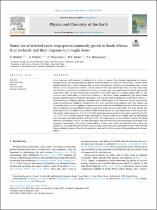| dc.contributor.author | Mazvimavi, D | |
| dc.contributor.author | Ntshidi, Z | |
| dc.contributor.author | Dzikiti, S | |
| dc.contributor.author | Mkunyana, Y | |
| dc.date.accessioned | 2022-07-27T15:17:46Z | |
| dc.date.available | 2022-07-27T15:17:46Z | |
| dc.date.issued | 2021 | |
| dc.identifier.citation | Ntshidi, Zanele & Dzikiti, Sebinasi & Mazvimavi, Dominic & Mobe, Nompumelelo & Mkunyana, Yonela. (2021). Water use of selected cover crop species commonly grown in South African fruit orchards and their response to drought stress. Physics and Chemistry of the Earth, Parts A/B/C. 124. 103070. 10.1016/j.pce.2021.103070. | en_US |
| dc.identifier.issn | 1474-7065 | |
| dc.identifier.uri | 10.1016/j.pce.2021.103070 | |
| dc.identifier.uri | http://hdl.handle.net/10566/7638 | |
| dc.description.abstract | Cover crops are widely planted in orchards for a variety of reasons. These include suppressing soil erosion, nutrient cycling, phytosanitary purposes, general orchard aesthetics etc. However, there is need to balance these benefits against use of scarce resources such as water and nutrients. Currently no information exists on how different cover crop species use water in orchards and how they cope with drought stress. The aim of this study was therefore to compare the transpiration dynamics of various cover crop types in order to identify species with conservative water use rates. Studied species included: 1) two exotic legumes i.e. Lupine (Lupinus albus L.), and Common vetch (Vicia sativa), 2) three exotic grasses i.e. Tall fescue (Festuca arundinacea), Rye grass (Lolium perenne), and Kikuyu grass (Pennisetum clandestium) and; 3) grasses that are indigenous to sub-Saharan Africa i.e. African Lovegrass (Eragrostis capensis) and Rhodes grass (Chloris gayana). The crops were planted in pots under controlled greenhouse conditions. Transpiration rates were quantified using miniature stem heat balance sap flow gauges and by manual weighing. Drought stress was imposed by withholding irrigation at selected intervals and the responses were quantified through changes in the water relations of the plants. The study showed that exotic legumes had the highest daily water use which peaked at about 2.4 L per square metre of leaf area per day, followed by exotic grasses at 1.5–2.0 L/m2/d. The indigenous grasses used the least water ranging from 0.8 to 1.2 L/m2/d. The indigenous grasses largely displayed an isohydric response to drought stress by maintaining their leaf water status with increasing soil water deficit. The exotic species, on the other hand, showed risk taking behaviour (anisohydry) wherein both the transpiration and leaf water status decreased sharply as drought stress increased. Consequently, some exotic species failed to recover when stress was relieved. From a water use perspective, this study demonstrates that indigenous grass species are more appropriate as cover crops in South African orchards because of their low transpiration rates and the ability to cope with extended periods of water deficit. © 2021 Elsevier Ltd | en_US |
| dc.language.iso | en | en_US |
| dc.publisher | Elsevier | en_US |
| dc.subject | Sap flow | en_US |
| dc.subject | Leaf water status | en_US |
| dc.subject | Soil water deficit | en_US |
| dc.subject | Stomatal conductance | en_US |
| dc.title | Water use of selected cover crop species commonly grown in South African fruit orchards and their response to drought stress | en_US |
| dc.type | Article | en_US |

